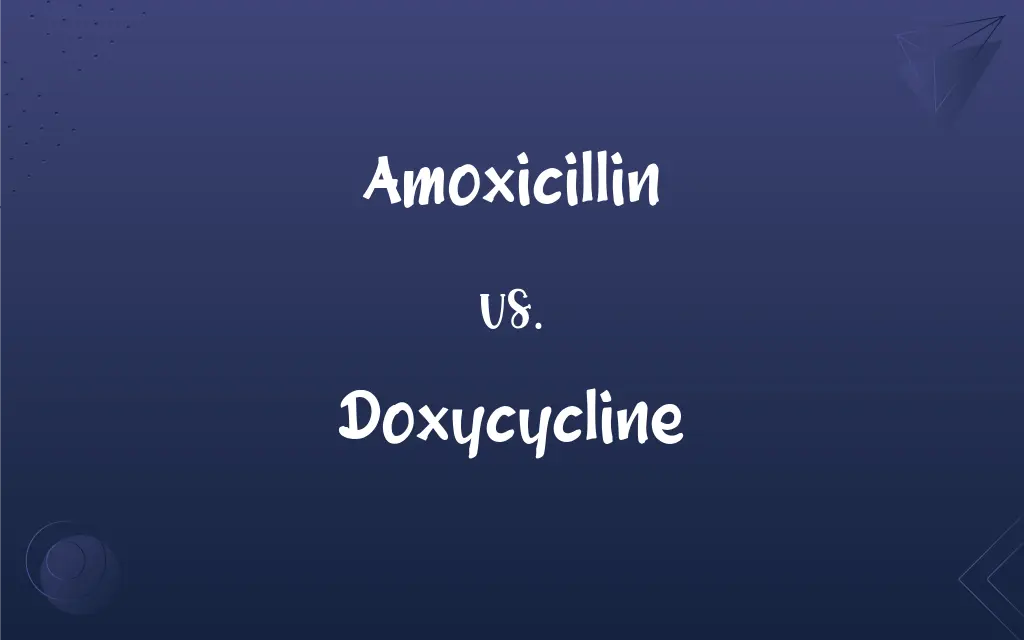Amoxicillin vs. Doxycycline: What's the Difference?
Edited by Janet White || By Harlon Moss || Updated on July 7, 2024
Amoxicillin is a penicillin antibiotic, while doxycycline is a tetracycline antibiotic.

Key Differences
Amoxicillin is an antibiotic that belongs to the penicillin family. Doxycycline, on the other hand, is a member of the tetracycline family.
Both of these antibiotics are used to treat a variety of bacterial infections. Amoxicillin is often prescribed for infections such as strep throat or ear infections, while doxycycline is commonly used for acne, Lyme disease.
The mechanism of action for amoxicillin involves disrupting the formation of bacterial cell walls, rendering them vulnerable. Doxycycline works differently, inhibiting protein synthesis in bacteria, thus stopping their growth.
Though both are antibiotics, they are prescribed for different conditions and have different side effects and interactions. It's important to note that amoxicillin can cause allergic reactions in those allergic to penicillin, whereas doxycycline is usually used as an alternative for those with penicillin allergies.
Comparison Chart
Class
Penicillin antibiotic
Tetracycline antibiotic
ADVERTISEMENT
Common Uses
Strep throat, ear infections
Acne, Lyme disease, some STIs
Mechanism
Disrupts bacterial cell wall formation
Inhibits bacterial protein synthesis
Allergy Concern
Risk for those allergic to penicillin
Alternative for penicillin-allergic folks
Form
Pill form
Typically in pill form
Amoxicillin and Doxycycline Definitions
Amoxicillin
Amoxicillin disrupts bacterial cell walls.
The bacterial infection couldn't survive the amoxicillin treatment.
ADVERTISEMENT
Doxycycline
Doxycycline is commonly used for acne treatment.
The dermatologist recommended doxycycline for his persistent acne.
Amoxicillin
Amoxicillin can cause allergic reactions in some.
Since he's allergic to penicillin, he can't take amoxicillin.
Doxycycline
Doxycycline works by inhibiting bacterial protein synthesis.
Bacterial growth was halted by doxycycline's action.
Amoxicillin
Amoxicillin can come in liquid or pill form.
The child was given liquid amoxicillin for easier consumption.
Doxycycline
Doxycycline can be used as an alternative for those allergic to penicillin.
She couldn't take amoxicillin due to her allergy, so she was given doxycycline instead.
Amoxicillin
Amoxicillin treats bacterial infections.
After a few days on amoxicillin, his ear infection improved.
Doxycycline
Doxycycline is usually in pill form.
He took the doxycycline pill with a glass of water.
Amoxicillin
Amoxicillin is a penicillin antibiotic.
She was prescribed amoxicillin for her strep throat.
Doxycycline
Doxycycline is a tetracycline antibiotic.
Doxycycline was prescribed to treat her Lyme disease.
Doxycycline
A broad-spectrum antibiotic, C22H24N2O8, derived from tetracycline.
FAQs
Is doxycycline safe for someone with a penicillin allergy?
Yes, doxycycline is often used as an alternative for those allergic to penicillin.
What infections is amoxicillin commonly prescribed for?
Amoxicillin is often prescribed for strep throat, ear infections, and more.
How does amoxicillin work?
Amoxicillin disrupts the formation of bacterial cell walls, killing them.
What is doxycycline?
Doxycycline is a tetracycline antibiotic used for various bacterial infections.
When is doxycycline typically prescribed?
Doxycycline is commonly used for conditions like acne, Lyme disease, and certain STIs.
What is amoxicillin?
Amoxicillin is a penicillin antibiotic used to treat bacterial infections.
How should doxycycline be stored?
Keep doxycycline in a dry place, protected from light.
Are there any known drug interactions with doxycycline?
Yes, doxycycline can interact with several drugs, always inform your doctor about all medications you're taking.
How does doxycycline function?
Doxycycline inhibits protein synthesis in bacteria, stopping their growth.
Can I drink alcohol with amoxicillin?
It's best to avoid alcohol when taking amoxicillin as it can reduce its efficacy and increase side effects.
Can I consume alcohol with doxycycline?
Drinking alcohol with doxycycline can lessen its effectiveness and cause side effects.
Are there any side effects of amoxicillin?
Yes, side effects can include upset stomach, diarrhea, and allergic reactions, among others.
What are some side effects of doxycycline?
Doxycycline can cause nausea, sun sensitivity, and yeast infections, among other side effects.
Can I take amoxicillin while pregnant?
Always consult a doctor, but amoxicillin is generally considered safe during pregnancy.
Can I take amoxicillin with other medications?
Always consult a doctor, as amoxicillin can interact with certain medications.
Can I take amoxicillin if I'm allergic to penicillin?
No, those allergic to penicillin should avoid amoxicillin.
Is doxycycline safe during pregnancy?
Doxycycline is not typically recommended during pregnancy; always consult a doctor.
Is doxycycline suitable for children?
Doxycycline is not usually recommended for young children due to potential tooth discoloration.
How should I store amoxicillin?
Store amoxicillin in a cool, dry place away from direct sunlight.
Can children take amoxicillin?
Yes, amoxicillin is often prescribed to children in an appropriate dosage.
About Author
Written by
Harlon MossHarlon is a seasoned quality moderator and accomplished content writer for Difference Wiki. An alumnus of the prestigious University of California, he earned his degree in Computer Science. Leveraging his academic background, Harlon brings a meticulous and informed perspective to his work, ensuring content accuracy and excellence.
Edited by
Janet WhiteJanet White has been an esteemed writer and blogger for Difference Wiki. Holding a Master's degree in Science and Medical Journalism from the prestigious Boston University, she has consistently demonstrated her expertise and passion for her field. When she's not immersed in her work, Janet relishes her time exercising, delving into a good book, and cherishing moments with friends and family.































































